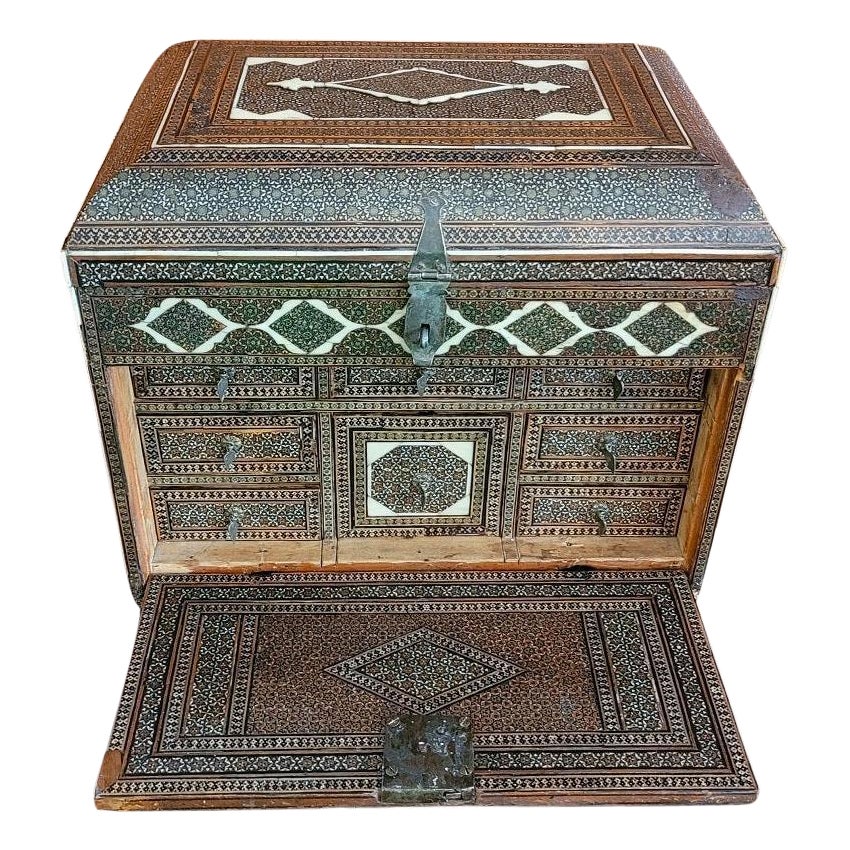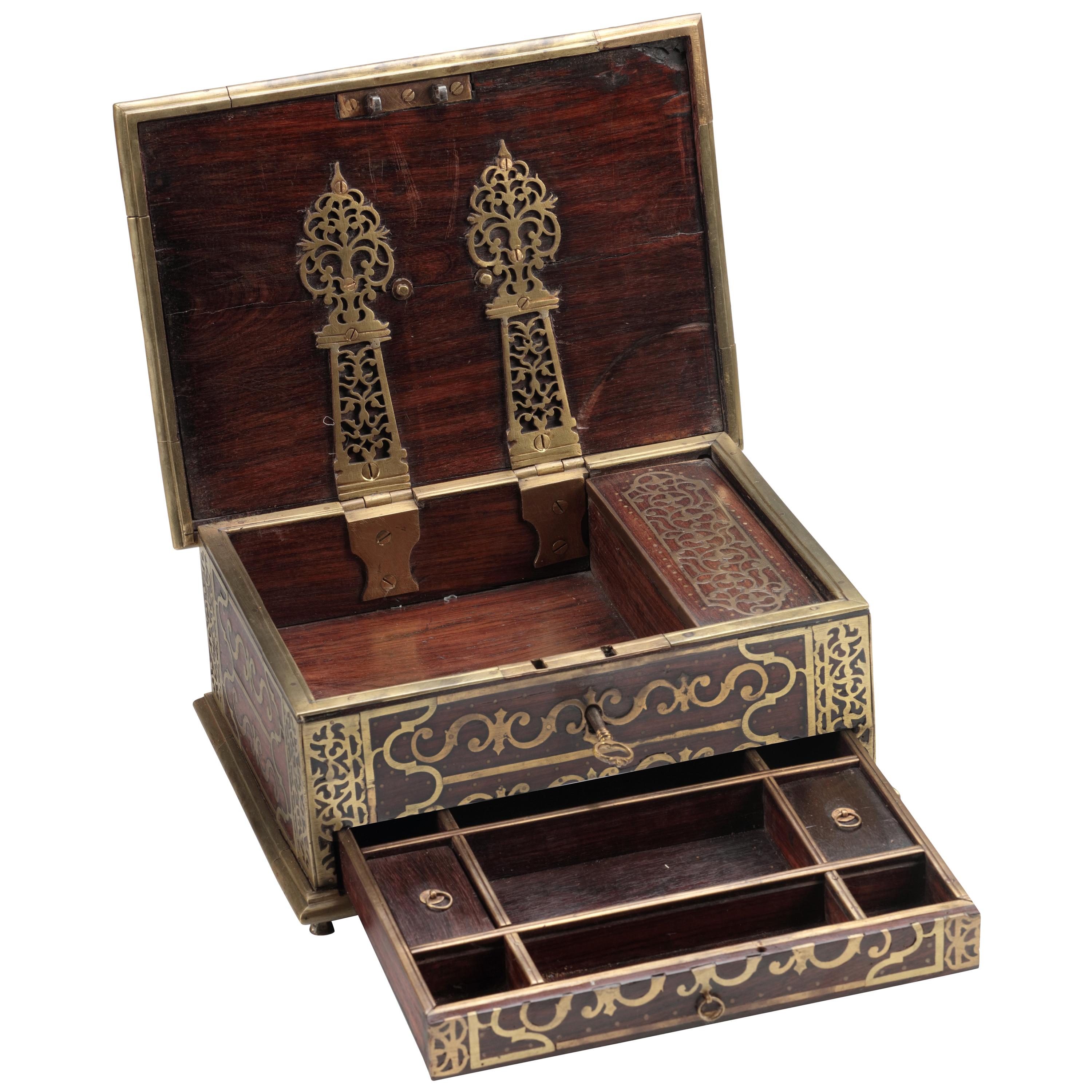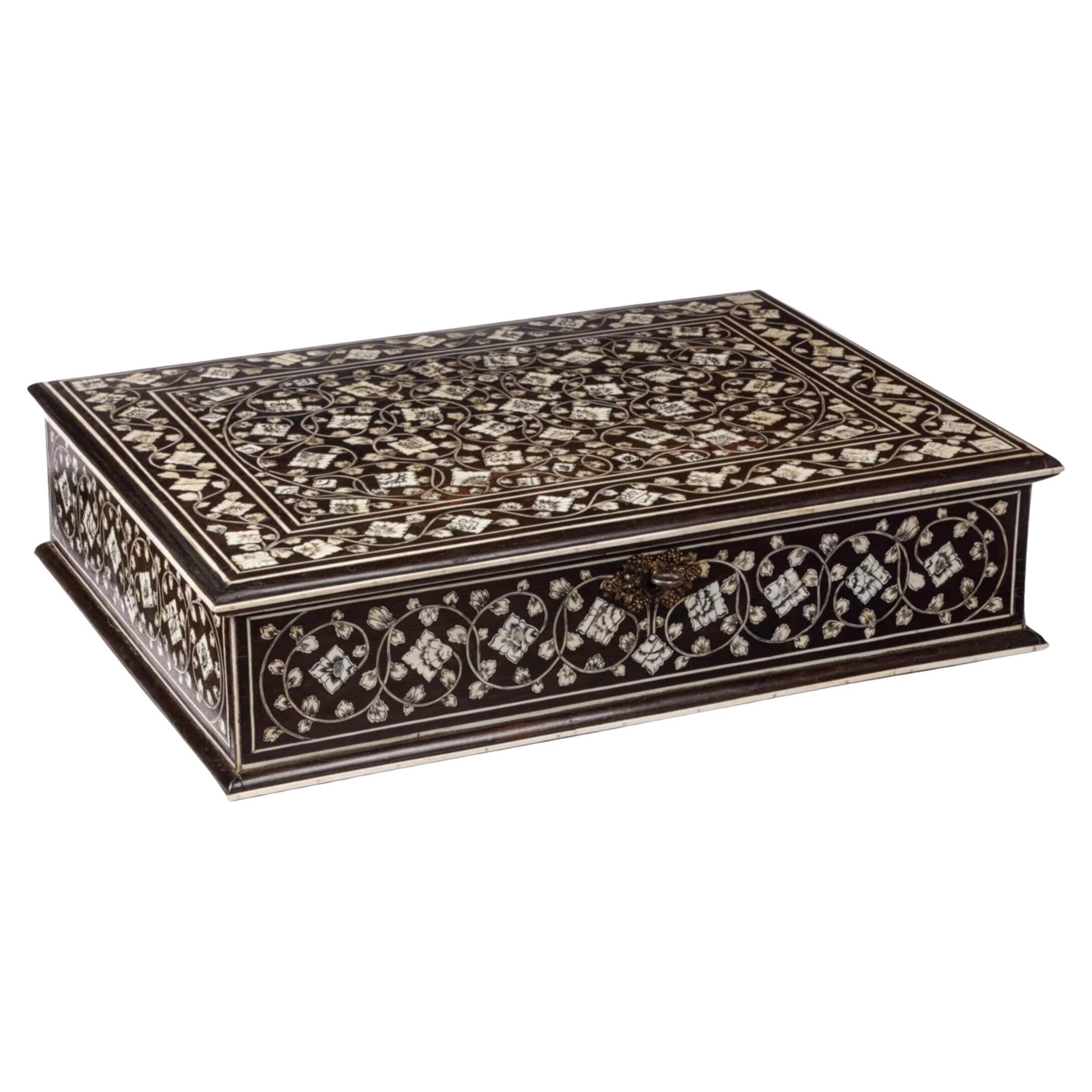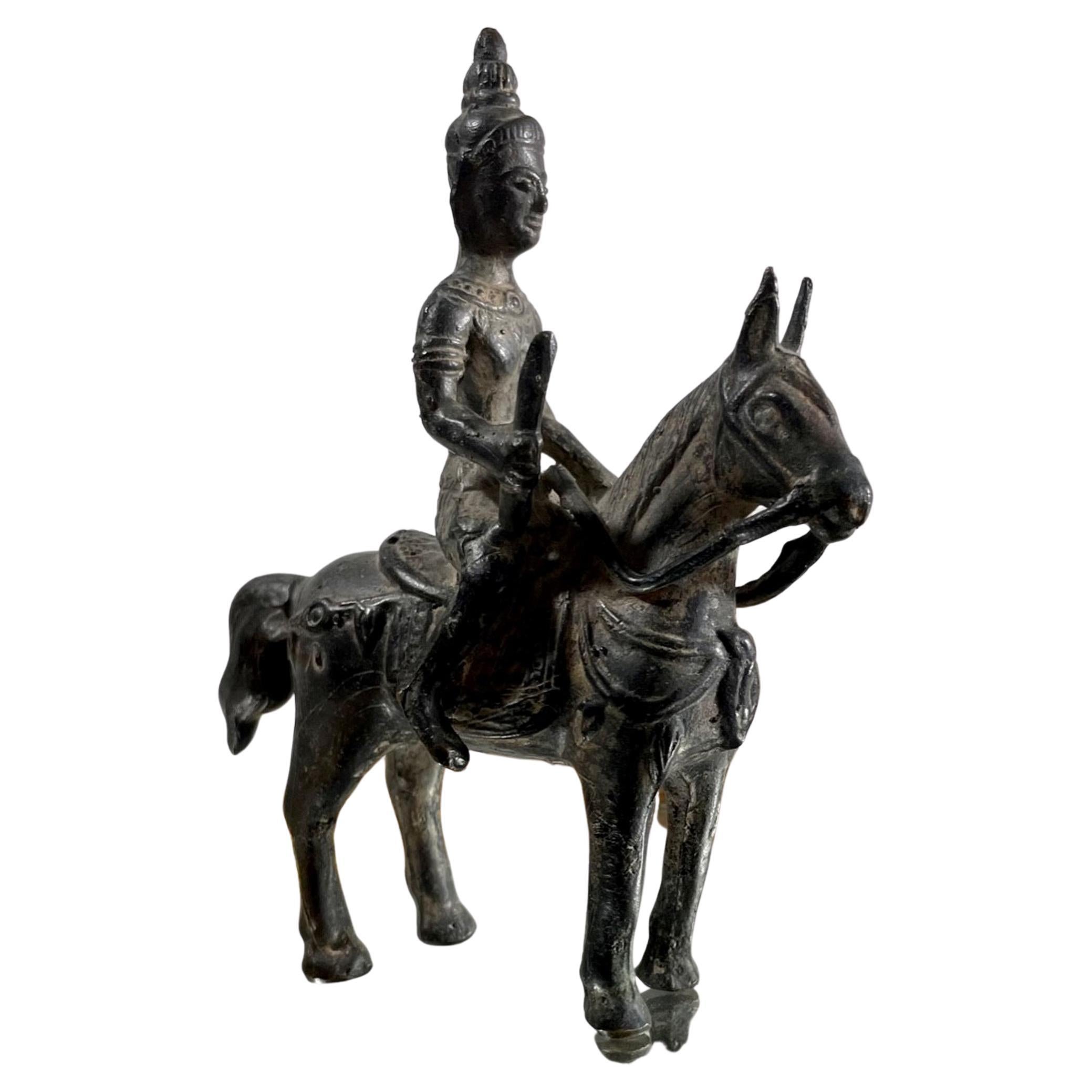Items Similar to Splendid Indo-Portuguese Colonial Sculpture of Nagini from Goa, 17th Century
Want more images or videos?
Request additional images or videos from the seller
1 of 8
Splendid Indo-Portuguese Colonial Sculpture of Nagini from Goa, 17th Century
About the Item
A fine Indo-Portuguese inlaid teak wood figure of Nagini
India, Goa, 17th century
Measure: H. 55 cm
(with stand, and with ring for wall hanging)
The sculpture can be perceived as such but probably is one of four legs of an Indo-Portuguese contador. These famous profusely inlaid cabinets are possibly the embodiment of colonial furniture. Depicted here are a Naga with a woman’s head and torso and a curling serpent’s lower body. Nagini
is the female version of the Naga, the Sanskrit word for a deity or class of entity or being, taking the form of a giant snake.
In Hindu religious culture, Nagas are considered nature spirits closely associated with water, rivers, lakes and seas, protectors of springs, wells and rivers, propitiating rain, and thus fertility.
They are object of great reverence even in modern times and especially in South India, where they are still worshipped as female deities, particularly by women devotees, bringing them fertility and prosperity. The Nagini serves an apotropaic function when part of a cabinet: to ward off evil intentions by protecting the contents hidden in this type of furniture used to store valuables, such as money, documents, jewellery and precious objects.
- Dimensions:Height: 21.66 in (55 cm)Width: 5.91 in (15 cm)Depth: 5.91 in (15 cm)
- Materials and Techniques:
- Place of Origin:
- Period:
- Date of Manufacture:circa 1650
- Condition:Wear consistent with age and use.
- Seller Location:Amsterdam, NL
- Reference Number:1stDibs: LU5458231674422
About the Seller
5.0
Vetted Seller
These experienced sellers undergo a comprehensive evaluation by our team of in-house experts.
Established in 1985
1stDibs seller since 2020
19 sales on 1stDibs
Typical response time: 3 hours
- ShippingRetrieving quote...Ships From: Amsterdam, Netherlands
- Return PolicyA return for this item may be initiated within 7 days of delivery.
More From This SellerView All
- 16th-Century Indo-Portuguese Colonial Mother-of-pearl Gujarat CasketLocated in Amsterdam, NLAn exceptional Indo-Portuguese colonial mother-of-pearl veneered casket with silver mounts India, Gujarat, 2nd half of the 16th century, the silver mounts Goa or probably Lisbon Measures: H. 16 x W. 24.6 x D. 16.1 cm An exceptional Gujarati casket with a rectangular box and truncated pyramidal lid (with slopes on each side and a flat top) made from exotic wood, probably teak (Tectona grandis), covered with a mother-of-pearl mosaic. The tesserae, cut from the shell of the green turban sea snail (Turbo marmoratus, a marine gastropod) in the shape of fish scales, are pinned to the wooden structure with silver ball-headed nails. The casket is set on bracket feet on the corners. The masterfully engraved decoration of the silver mounts follows the most refined and erudite Mannerist repertoire of rinceaux and ferroneries dating from the mid-16th century. The high quality and refinement of the silver mounts and, likewise, the silver nails that replaced the original brass pins used to hold the mother-of-pearl tesserae in place indicate the work of a silversmith probably working in Lisbon in the second half of the 16th century. The Indian origin of this production, namely from Cambay (Khambhat) and Surat in the present state of Gujarat in north India, is, as for the last three decades, consensual and fully demonstrated, not only by documentary and literary evidence - such as descriptions, travelogues and contemporary archival documentation - but also by the survival in situ of 16th-century wooden structures covered in mother-of-pearl tesserae. A fine example is a canopy decorating the tomb (dargah) of the Sufi saint, Sheik Salim Chisti (1478-1572) in Fatehpur Sikri in Agra district in the state of Uttar Pradesh, north India. This is an artistic production, geometric in character and Islamic in nature, where usually the mother-of-pearl tesserae form complex designs of fish scales or, similar to the dishes also made using the same technique, with the thin brass sheets and pins, stylized lotus flowers. The truncated pyramidal shape corresponds, like their contemporary tortoiseshell counterparts also made in Gujarat, to a piece of furniture used in the Indian subcontinent within the Islamic world prior to the arrival of the first Portuguese. This shape, in fact, is very old and peculiar to East-Asian caskets, chests or boxes used to contain and protect Buddhist texts, the sutras. A similar chest is the famous and large reliquary chest from Lisbon cathedral that once contained the relics of the city's patron saint, Saint Vincent. Both match in shape, having the same kind of socle or pedestal and bracket feet, and in their engraved silver mountings, featuring the same type of refined, erudite decoration. Their differences lie in the silver borders that frame the entire length of the edges of the chest (both the box and the lid), pinned with silver nails, and on the lock plate, shaped like a coat of arms in the Lisbon example. Given the exceptional dimensions of the reliquary casket...Category
Antique 16th Century Indian Jewelry Boxes
MaterialsSilver
- 17th century colonial Sinhalese ebony two-door cabinet with silver mountsLocated in Amsterdam, NLA splendid Dutch-colonial Sinhalese ebony two-door cabinet with silver mounts Sri Lanka, Kandy, 2nd half 17th century, the mounts later The cabinet with a central drawer with hidde...Category
Antique 17th Century Sri Lankan Dutch Colonial Jewelry Boxes
MaterialsSilver
- Colonial Islamic Arabian Market Jewelry Box, 18th Century, India/Malabar CoastLocated in Amsterdam, NLAN INDIAN ROSEWOOD AND EBONY BRASS MOUNTED BOX FOR THE ISLAMIC MARKET Malabar Coast, 18th century With a large drawer with several compartments under a lid with two com...Category
Antique 18th Century Indian Islamic Jewelry Boxes
MaterialsBrass
- 18th century Dutch-Colonial ‘Vizagapatam’ pen-engraved bone inlaid ebony boxLocated in Amsterdam, NLA large Indian Colonial ‘Vizagapatam’ pen-engraved bone inlaid ebony box Masulipatnam or Vizagapatam, 2nd half 18th century H. 10.8 x W. 47 x D. 34 cm ...Category
Antique Late 18th Century Indian Dutch Colonial More Asian Art, Objects ...
MaterialsBone, Ebony
- Fine 17th Century Dutch Colonial Armorial Tortoiseshell & Silver Box, Dated 1691Located in Amsterdam, NLA dutch tortoiseshell box with two engraved silver plaques Amsterdam, 1691, with maker's mark of Steven des Rousseaux (1654-1733) H. 5 cm Diam. 12.5 cm Note: Steven des ...Category
Antique 17th Century Dutch Sterling Silver
MaterialsSterling Silver
- Fine 17th Century Japanese Export Black and Gold Lacquered Pictorial-Style DishLocated in Amsterdam, NLA fine Japanese export black and gold lacquered pictorial-style dish Nagasaki or Kyoto, 1680-1720 The dish with wide flat rim of Keaki wood (Zelkova species) in black lacquer with...Category
Antique 17th Century Japanese Edo Lacquer
MaterialsGold
You May Also Like
- 18 C, Indo-Portuguese Vargueno Mini CabinetLocated in Dallas, TXPresenting a fabulously rare 18c Indo-Portuguese Vargueno mini cabinet. Extremely rare, highly important and desirable colonial piece ! It is an In...Category
Antique Late 18th Century Indian Anglo-Indian Decorative Boxes
MaterialsBrass
- Indian Hindu Bronze Sculpture of Khandoba, 17th / 18th CenturyLocated in Vero Beach, FLIndian Hindu bronze sculpture of Khandoba 17th/18th century The bronze figure on horseback represents the most popular Hindu deity Khandoba, an avatar...Category
Antique 18th Century Indian Other Sculptures and Carvings
MaterialsBronze
- Antique Handmade Wood Money Box with Hardware from 19th Century, ChinaLocated in Yonkers, NYAn antique handmade Chinese money box with metal hardware from the 19th century. This rectangular box is made of two-tone wood. The front displays a ...Category
Antique 19th Century Chinese Decorative Boxes
MaterialsBrass
- 17th century Antique bronze Burmese Buddha statue from BurmaLocated in DEVENTER, NLThis antique bronze Buddha statue is a truly unique and special collectible piece. Standing at 25.4 cm high, 14.2 cm wide and 10.4 cm deep, it is made of bronze and it weighs 1.53 kg...Category
Antique 17th Century Burmese Sculptures and Carvings
MaterialsBronze
- Large 17th Century Wooden Burmese Monk Statue from BurmaLocated in DEVENTER, NLMaterial: wood Measures: 187 cm high 39,5 cm wide and 34,5 cm deep With traces of 24 krt. gilding Ava style Namaskara mudra Originating from Burma 17th century.Category
Antique 17th Century Burmese Sculptures and Carvings
MaterialsWood
- Large 17th Century Wooden Burmese Monk Statue from BurmaLocated in DEVENTER, NLMaterial: wood 180 cm high 43 cm wide and 34,5 cm deep With traces of 24 krt. gilding Ava style Namaskara mudra Originating from Burma 17th century.Category
Antique 17th Century Burmese Sculptures and Carvings
MaterialsWood





